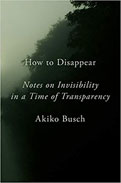
 |
How to Disappear: Notes on Invisibility in a Time of Transparency
by Akiko Busch
Penguin Press
The conundrum of being unseen in a world that lauds and demands visibility is explored in Busch’s thoughtful series of essays. It’s too simplistic to say that some people and things are overexposed, while others create an enigma. An inclusive or disruptive formula arises in all appearances. Through her poignant writing, Busch explores various ways people and things present themselves and achieve new interpretations.
The approaches here are more vast than you might imagine, covering the entire karmic spectrum of body, mind, and spirit, as well select nonhuman elements of the Earth. Busch effortlessly proceeds from her invisible friends of childhood and the concept of self-awareness and existence through the philosophical and psychological aspects of identity across cultures and landscapes. Identity is more than our self-perception. It relies on external factors, such as association, impact, and even where we place our feet on the planet. Ironically, the more we reveal ourselves to the world, the more we lose ourselves, increasing our invisibility in plain sight. For example, this reviewer is an author, at times in the bulls-eye of various public forums by necessity of trade. Most authors are well aware of the game afoot, cloaking themselves for privacy and security yet remaining in-part authentically exposed to the audience.
While there is a fundamental need to shelter our more valuable and vulnerable assets, there simultaneously exists a need to exploit them for advantage, which for some has reached a psychosis stage of “look at me.” Much of this is observed through digital media, although artists have been employing funhouse mirrors and other screening devices for years. For example, Andy Warhol and Bob Dylan simply manufactured their histories and lived forward and still exist through the prism of a celebrated popular view. In a way, we all revise our childhoods wrought sometimes painfully through circumstance in order to thrive by a more self-described version of ourselves in the present. To various degrees, we dream of alternate futures, where we look, feel, and move differently. This commotion roils below the surface and hides within dreams, eclipsed from the naked eye. In effect, everyone’s true self is invisible, sometimes even to our own consciousness.
At times, Busch’s essays read like ruminations, more intent to span the colors of thought through numerous examples rather than land on a singular point. While this method inspires debate, a blurred image is the seed of invisibility: to resist understanding or at least skew perception if not outright manipulate it for effect. It’s all camouflage in the end. We want to be appreciated for who we truly are, yet we offer skins to the world that we think are better suited to preference, success, and survival. In the modern world of endless surveillance and staring, it might be increasingly harder to become unseen, even hold onto ourselves.
RECOMMENDED by the US Review
Next Focus Review
Previous Focus Review